Here’s a guest post by Lauren Van Mullem, a recent participant on our New Orleans Culinary Tour.
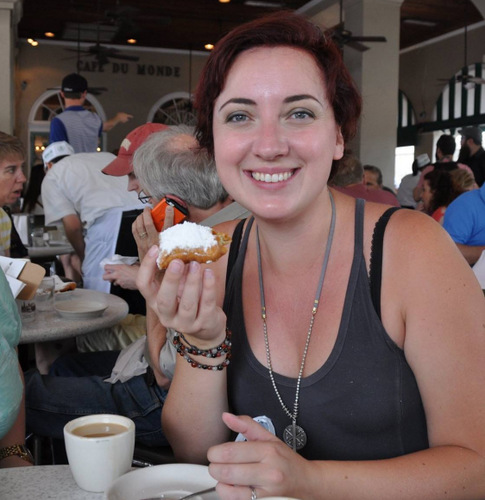
It seemed like wherever we went, if you scratched the surface of the story behind a restaurant or historic home you’d find a woman holding up the foundations. Not literally—that would be creepy. Granted, this is the town for creepy too (Voodoo is alive and well). But strong women were part of New Orleans from the beginning, and they are as much part of the culture as Creoles, Cajuns, Africans, Germans, Italians and natives. Maybe even more so.
Consider the Ursuline nuns, for example: A dozen women who traveled to New Orleans from France in 1727, bringing medical care and education with them, then establishing an orphanage. One of these original twelve was, like myself, an avid gardener and went to work creating a medicinal herb garden—becoming the first woman pharmacist in the New World. And, New Orleans garnered quite the reputation for its pharmacists after that (ever heard of Peychaud’s bitters? Created by a NOLA pharmacist for medicinal purposes). You might say she started a trend.
I could tell you so many stories of women who’ve made their marks on this town without even brushing such characters as Marie Laveau and her doppelganger daughter. But, for brevity, since others have covered this turf before me, I’ll stick to those I encountered in person:
A take-no-crap Creole
A force of nature
The woman who stopped a riot (with corn bread)
My favorite chef
A rebel daughter
Two savvy entrepreneurs
A colorful culinary historian
And a ghost
The Women of New Orleans
Marie LaCoste is one tough lady. I wouldn’t dare ask her age, but if I had to guess, it would be over seventy. Marie was our culinary tour guide on the first day, and within five minutes we knew four things about her: She was a New Orleans native, she had a wicked sense of humor, she’d had a lot of kids, and she took zero crap from anyone. By minute six, I would have followed her anywhere.
So, it’s a good thing she took us to some really delicious and historic places, like Antoine’s (opened in 1840, invented Oysters Rockefeller), Arnaud’s (opened in 1918, known for its Shrimp Remoulade) and Tujague’s (pronounced “two jacks,” opened in 1856 by a woman: Marie Abadie Tujague).
Katrina—yes, that Katrina—is the second lady on my list. Katrina didn’t touch the French Quarter, and as for the rest of town…that wasn’t all her doing. That was a man-made disaster. The levee walls weren’t prepared to handle a Category 5 hurricane, and when they fell, water flooded into 80% of the city. Our Katrina tour guide would point to roof tops to show us how high the water came. Can you imagine water reaching the top of your local supermarket? I couldn’t, until I saw the X marks high on the sides of buildings, left by rescue workers in boats searching for survivors.
If the levees had been built better, if the wetlands had been preserved, if corners hadn’t been cut in construction, if the politicians weren’t corrupt, if, if, if. Tragedies leave more ifs in their wakes than anything else. But Katrina isn’t without her silver linings.
We met one of these silver linings on the way back from Mulate’s Cajun Restaurant. She was our pedicab driver, the first female pedicab driver I’d seen in the French Quarter. We were chatting—I wondered how she dealt with the overly flirtatious men I’d noticed (and been noticed by) on Bourbon Street—and found out that she drove pedicabs to support herself while she volunteered to help rebuild homes in the Ninth Ward. Another strong woman.
Madame Langlois, the namesake of Langlois Culinary Crossroads cooking school (where we had our hands-on cooking class) was the cook for Governor Jean Baptiste Le Moyne. But the story really starts in 1704 with 24 French girls who arrived on the shores of New Orleans to marry the French soldiers and settlers. These ladies may have been poor in Paris, but they had eaten well and were not braced for the limitations of the New World culinary scene. European-friendly vegetables, herbs and flour were in short supply, which really ticked them off after being promised a better life in the New World. These women could handle the mosquitoes and survive yellow fever, poor plumbing and miserable weather, but they needed fresh French bread to do it. So they banged their pots and pans beneath the governor’s windows demanding better food.
The governor sent his housekeeper, Madame Langlois, to teach the girls how to cook with local ingredients, substituting French bread (wheat does NOT grow well in Louisiana, folks) for corn bread. Mme. Langlois essentially started the first cooking class and, many say, founded Creole cuisine. Where did Mme. Langlois learn? From the native Choctaw squaws, who taught her how to make hominy and grits and use sassafras to thicken gumbo—a recipe that came with the African slaves.
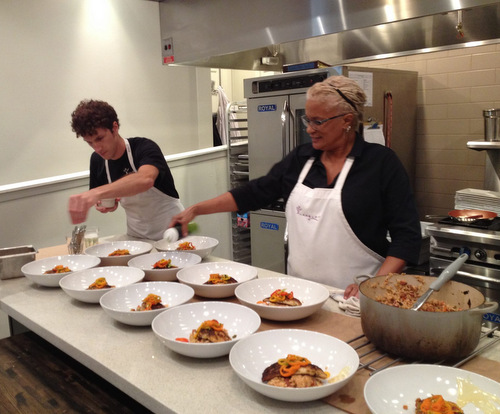
Chef Melisand Colomb. Of all the women I met in New Orleans, Chef Mel is my favorite. I will never forget this woman because, without her, I wouldn’t know how to make a real Creole roux (vital for gumbo and etouffee). She was our instructor at the Langlois Culinary Crossroads cooking class, and friends—I have taken a lot of cooking classes. Cooking is my thing, my bag, my passion. And I have never learned so many pro tricks of the trade as I did from Chef Mel.
Do you know how rare it is to find a chef who will let you in on all the little secrets and subtle techniques that make the difference between home cook and professional chef? That requires a generosity of spirit you don’t often find, even in a cooking class. But that’s her. She’s amazing like that. And I will remember her every time I make gumbo, or tasso, or buy Emeril’s Creole Seasoning (because it has less sodium, and controlling salt is Cooking 101). I’d go back to New Orleans in a heartbeat, just for one more cooking class with her.
Laura is a plantation roughly 50 miles outside of New Orleans proper. It’s also the name of Laura Locoul, the last woman of four generations of women who ran this plantation while the men dropped out from under them.
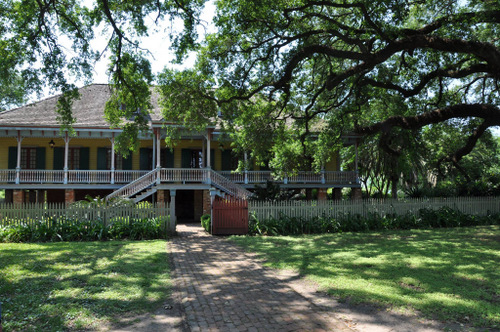
These were strong women. Ruthless women. Women who weren’t always nice or kind. Elisabeth Duparc, Laura’s grandmother, ran the show for 47 years, building the business, acquiring land, and acquiring (and “breeding”) more than 170 slaves. Unsurprisingly, she wasn’t the warm and fuzzy grandma type. Laura’s mother Desiree Arnichard was a tough cookie too (had to be to stand up to her mother-in-law), but was a much nicer person. Laura inherited a strong will and sharp wits from both sides and demanded an education in New Orleans. Though it’s not in her memoirs, the consensus seems to be that she felt the weight of her family’s sins and couldn’t get away from the plantation lifestyle fast enough. She learned English, went to school and married a nice guy from St. Louis.
But Laura—the plantation—is remarkable not only for the Creole women in the big house, but also because its current owners choose to tell the other side of the story as well. The slavery side of the story. Most plantation tours tread very lightly on the topic of slavery. Some don’t mention it at all, focusing instead on the architecture and furnishings of the main house. Some even claim their slaves were so happy they didn’t want to leave after being freed. The Laura tour doesn’t shy away from the atrocities that happened. They own up to it all, the good, the bad, the ugly, the unthinkable.
Tujagues, the second oldest restaurant in New Orleans (which we visited with Marie LaCoste and returned to for dinner) was created by Mrs. Tujague in 1856 when she started serving brunch to dock workers, butchers and market workers. Brunch was a seven-course affair and Mrs. Tujague quickly established a reputation for her shrimp remoulade and beef brisket. But, a few doors down, another woman was making Sunday brunch—Elizabeth Kettenring Begue, a sturdy German lady who became the first celebrity chef of New Orleans. Tourists would reserve seats months in advance, and in 1900, the Southern Pacific Railroad published “Mme. Begue’s Recipes of Old New Orleans Creole Cookery” as a marketing incentive. Fun fact: Mr. Begue was eight years younger and started his career as the “hot bartender.” When Mrs. Begue died, Mr. Begue married her kitchen assistant (who knew all of her recipes) and bought out Tujagues, relocated there and kept the name.
And, it was one of the best meals we had in New Orleans—their gumbo and shrimp etouffee are unforgettable, and that original brisket recipe ain’t bad either.
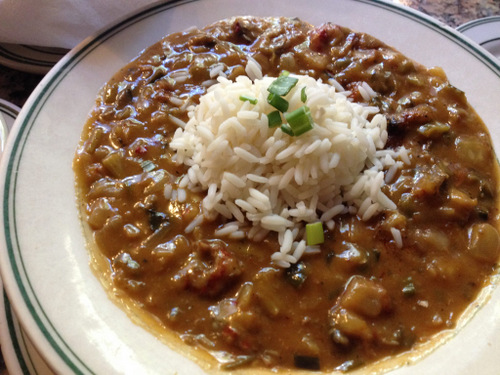
Poppy Tooker is a native New Orleanian, host of the NPR affiliated show Louisiana Eats! and was the woman in charge of taking Mme. Begue’s Recipes of Old New Orleans Creole Cookery into the modern age—ie. making the recipes possible for today’s home chefs to follow. She introduced us to the story of Tujagues and the Begues, and the ghost of Mrs. Begue, all while whipping up a mouthwatering gumbo.
But I didn’t meet the ghost of Mrs. Begue—that’s Poppy’s story and well worth hearing. My ghost was waiting at the Bourbon Orleans hotel, which bills itself as “the most haunted hotel in New Orleans.”
The Ghost, one of 17 spirits haunting the Bourbon Orleans hotel, is said to be that of a quadroon mistress who dances by herself under the crystal chandeliers of the Orleans Ballroom. The Orleans Ballroom was built in 1817, adjacent to the Orleans Theater, which made it easy for Creole men to drop their families off at a play and… go play themselves. The ballroom was the venue for the famous and infamous quadroon balls, where mixed-race young women would gather to attract wealthy Creole men.
Once he’d chosen a young lady, a man would bargain with her mother, offering a house, servants, slaves, horse and carriage, jewelry, and spending money for the duration of the relationship (which often lasted for years), and sometimes even a “retirement” stipend. Male children of these unions were frequently educated in France. Female children usually followed in their mothers’ footsteps.
Some say it was like a marriage. Some say it was blatant exploitation of girls who had no choices. My guess—it was both. There is this one story of a man who was so madly in love with his quadroon mistress that he never married and left her everything in his will. His family was furious and sued the woman for the inheritance, but the judge upheld her claim.
I’m fascinated with these stories. Which is why I overcame my natural aversion to the undead (I’m seriously scared of ghosts, it’s embarrassing), and found the ballroom. As I attempted to peer into the room through the slim crack between the double doors, the custodian noticed me and asked if I’d like to see inside. Yes! He unlocked the doors and went back to cleaning outside, leaving me alone in a space that was elegant, yet seemed too small to hold so much history.
Can I say this without sounding crazy? I have a really good gut-check system for ghostly energies. And when I walked into that room, I felt a weight settle on my chest that was unmistakable. I hadn’t felt it anywhere else in the hotel (and thankfully not in my room), but there, under those crystal chandeliers, I felt the heaviness of heartbreak.
Was it a quadroon courtesan? Was it my over-active imagination? Who knows.
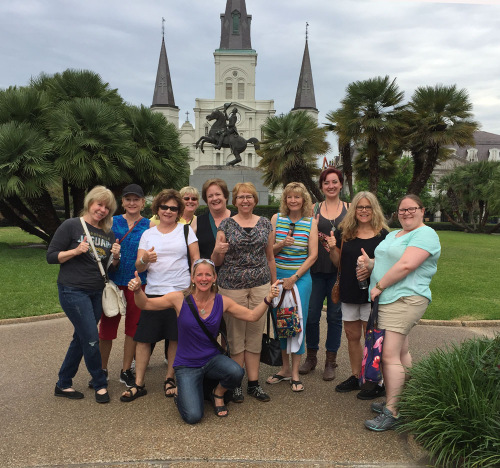
The other women: The nature of a women-only tour is to be thrown in with a dozen women in close quarters, which most of us don’t get to do on a regular basis. For me, observing these women, most of whom are older than I am, helps me to sort out exactly what kind of woman I want to be when I grow up (I’m 31, which means I feel ancient half the time and like a kid the other half). The women I met on this tour are role models for strength, adventurousness, graciousness, bravery, creativity, vibrancy, wisdom and joy—every bit as much as the women who call New Orleans home.
Lauren Van Mullem is a freelance writer and marketer who likes to wear frilly dresses, but also enjoys getting her hands dirty in her garden. She’s a former employee of Wanderlust and Lipstick and has traveled with Beth to India and most recently, New Orleans. If you’d like to connect with Lauren, you can reach her at Truer Words by Lauren.
To stay up-to-date on all things WanderTours, follow us on Facebook and subscribe to our blog via email or RSS.
Photo credits:
Group at St. Louis Cathedral – Beth Whitman
All other photos by Lauren Van Mullem
 Delicious Diwali Desserts and Foods
Delicious Diwali Desserts and Foods